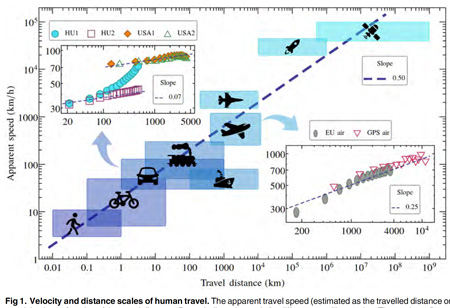Mathematically speaking, distance and travel time now — in this technological age — have a relatavistical relationship, even at speed far, far lower than the speed of light. This new study explains:
“Further We Travel the Faster We Go,” Levente Varga, András Kovács, Géza Tóth, István Papp, Zoltán Néda, PLoS ONE, 11(2): 2016, e0148913. The authors, at Babeş-Bolyai University, Romania, Edutus College, Hungary, and the Hungarian Central Statistical Office, report:
“The average traveling speed increases in a nontrivial manner with the travel distance. This leads to scaling-like relations on quite extended spatial scales, for all mobility modes taken together and also for a given mobility mode in part. We offer a wide range of experimental results, investigating and quantifying this universal effect and its measurable causes. The increasing traveling speed with the travel distance arises from the combined effects of: choosing the most appropriate travelling mode; the structure of the travel networks; the travel times lost in the main hubs, starting or target cities; and the speed limit of roads and vehicles….

“From our everyday experience we have learned, that the travelling time does not scale linearly with the travel distance. It might take several hours to travel at distances of a few hundreds of miles, but not significantly more to travel at the opposite side of the Earth. This is of course due to the fact that for smaller distances we use slower transportation modes, cars or commuting trains with many stops, while at larger scale we travel faster by airplanes or high-speed trains. Similar observations can be made for urban travel. In cities, travels at shorter distances are dominated by bus travel or walking, while at larger distances faster modes (trains or metro) are used. We recall here the surprising and extreme result, according to which in some major cities (like Boston or Lisbon) the commuting time is roughly independent of the commuting distance. Analysing the British public transportation system, it has been also proved that in general urban travels are multimodal with significant connection times between different modes. The combined effects of these modes and waiting times leads to a sub-linear dependence of the travelling time as a function of the travel distance.
“Surprisingly however, even if we do focus on the same travelling mode we still find an increasing effective speed with distance….”